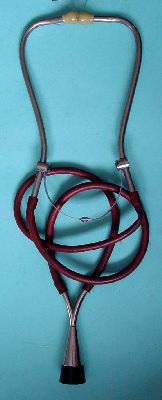Innere Medizin |
||
Stethoscope (6) |
||
- Eine erste Verbesserung des Stethoskopes erfolgte 1832, indem ein flexibles Teil eingefügt wurde (Charles James Blasius WILLAIMS). - Schon 1829 erdachte Nicholas COMIS ein binaurales Hörrohr. Die Idee wurde erst 1851 - eine Generation später - durch Nathan MARSH aufgegriffen, der ein Stereo-Stethoskop in Cincinnati vorstellte, ein unhandliches Gerät. 1852 stellte der New-Yorker Arzt Georges CAMMANN das erste handliche Modell vor.
"The first “stethoscope” was constructed of stacked paper rolled into a solid cylinder shape by Rene’ Laennec, a French physician, in 1816. After great success he would make new models out of wood. Prior to this invention physicians would place their ear to the patient’s chest to hear sounds of the lungs and heart. This type of stethoscope is called a “Monaural” stethoscope due to it having only one earpiece. To make your very own simple working model see the instructions below. Monaural stethoscopes for listening to an unborn baby’s heartbeat are still made today. As time went on many other stethoscopes were developed and made from different materials such as various woods (pine, ebony, cedar), metallic wire tubing, gutta-percha, ivory, metal, India rubber.
Etappen - 1829 - Binaural Stethoscopes (two earpiece models) make their debut, but not with much success by a doctor in Dublin. - 1860s - The Camman Stethoscope, a binaural model with a bell shaped chest piece is now considered the standard for superior “auscultation” (to listen to sounds in the chest) by American physicians. It would soon be followed by the Ford model. - 1890s - A physician & surgeon supply catalog offers stethoscopes from 40 cents for a simple wooden monaural model up to $4.00 for a fancier binaural example.
Exponat Vorgestellt wird ein Stethoskop, das noch ohne Membran arbeitete, ein trichterförmiges Stethoscop nach SNOWDEN resp. FORD (1885).
Quelle: |




